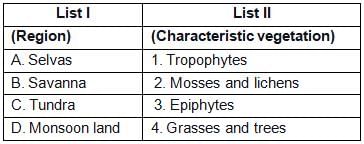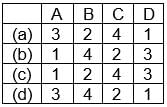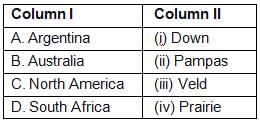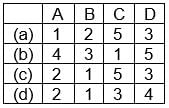Test: Biodiversity And Environment - UPSC MCQ
25 Questions MCQ Test - Test: Biodiversity And Environment
Which of the following is/are the characteristic(s) of Tropical Deciduous Forests?
(i) Trees shed their leaves in the dry season to conserve water
(ii) The hardwood trees found in these forests are sal, teak and Sheesham
(iii) Tigers, lions, elephants and monkeys are common animals

Match the animal with its habitat and accordingly select the correct alternative:

Match the animal with its habitat and accordingly select the correct alternative:
Which type of soil is found in the coniferous forests?
The percentage of forest cover is the highest in
The wide treeless grassy plains in South America are called
Sal trees are the typical species of [NDA 2009-II]
Which one of the following statements on biosphere reserves is not correct?
The vegetation type characterized by
(i) a large expanse of grassland with scattered trees and shrubs,
(ii) lying between the tropical rainforest and tropical steppes and deserts and
(iii) flat-topped trees is called
Which one of the following is the correct sequence about various levels of organization of the Biosphere?
Match List-I and List-II and select the correct answer using the code given below the

Codes:

Which one of the following countries is devoid of Glossopteris flora?
Which of the following is the odd one out of the group?
Which one of the following is not an abiotic resource?
Consider the following statements and select the correct answer from the codes given below:
Assertion (A): The production of rubber is decreasing in the Amazon.
Reason (R): Equatorial climate is favourable for rubber plantation.
Codes:
Which one of the following is a temperate desert?
Which one of the following is not a tropical desert?
Consider the following statements and select the correct answer
from codes given below:
Assertion (A): Tropical areas get more insolation than the temperate area.
Reason (R): Tropical areas have a larger length of the day than the temperate areas.
Codes:
























